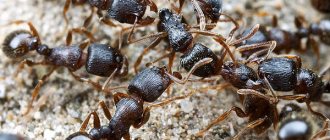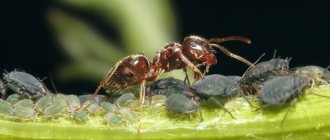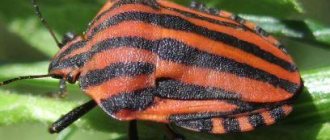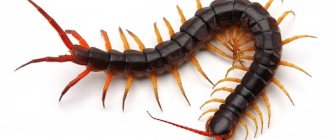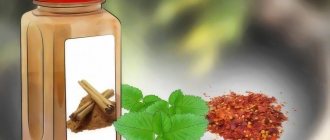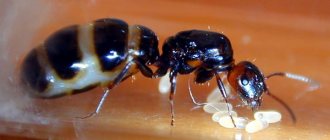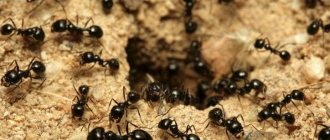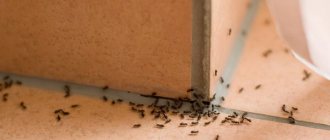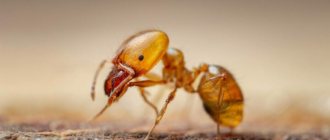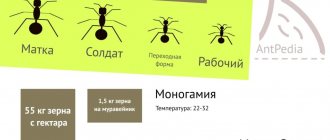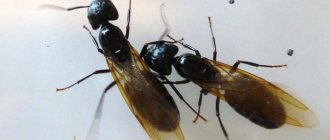A frequently asked question is the benefits and harms of ants in life and farming. Having seen ants on their property, some people rush to stock up on various preparations to kill them, while others do not pay attention to these insects, arguing that there are no problems on their part.
So what can you expect from ants - harm or benefit? This problem requires a solution.
Benefits and harms
Ants are one of the most common insect species on the planet. They live everywhere except Antarctica. Scientists estimate that their population accounts for 10 to 25% of the planet's total biomass.
There are 3 most common types of ants in Russia:
- turf (meadow);
- garden (turf);
- red (forest).
Small insects are not at all harmless. They are active predators and are quite capable of suppressing focal outbreaks of plant pests. Residents of an average anthill destroy up to 2000 caterpillars, larvae, midges, slugs and their eggs in one day. The soil next to anthills has a loose structure, enriched with oxygen, potassium and phosphorus, necessary for nutrition and normal growth of plants. This soil absorbs moisture well. The ants themselves serve as food for birds and as a means of disinfecting their plumage.
Despite the obvious benefits, they can cause a lot of damage to summer residents. Insects are known to have a sweet tooth. Having settled in houses or apartments, they cluster in places where sugar, honey and other sweets are stored. In summer cottages they eat berries. Ants especially love strawberries, gooseberries and currants. Sweet pears and other fruits do not go unnoticed by them.
Ants cause great damage to seedlings. They easily gnaw its succulent stems and fragile roots. Experienced flower growers know the threat they pose to flower beds, working on a much larger scale than moles. Along with loosening the soil, they spread weed seeds throughout the area.
In summer cottages inhabited by ants, aphids always breed. In the 18th century, Carl Linnaeus called the aphid the cow ant. Ants specially spread it around the area, planting it on young shoots of plants, while controlling the population size. When there are too many aphids, they begin to eat them.
Ants need aphids to produce honeydew. It has a sweet taste and is secreted by the rear part of the aphid. The ants crawl towards her from behind and begin to tickle her with their antennae. These touches provoke the release of honeydew, which is eaten by ants with great appetite.
Ants can also pose a danger to humans. Their bites can cause skin irritation, an allergic reaction, or cause breathing problems, including angioedema.
Their presence in the house causes great inconvenience to a person. It is unpleasant to find insects in a sugar bowl, a vase of cookies or sweets. The presence of ants in the house becomes a real disaster for people.
Should I fight ants?
It is a common belief that ants are beneficial insects, and this is partly true. For example, they protect plants from various pests:
- Butterfly caterpillars;
- flies (larvae);
- spider mites;
- slugs and others.
Thus, a colony of one medium anthill can destroy up to 2000 small insects per day, which is undoubtedly useful for the garden. On the other hand, if the invasion is too strong, it will inevitably lead to negative consequences, because:
- Ants contribute to the spread of aphids. They protect it from other insects, and “in gratitude” they receive a sweetish secretion, which is secreted by aphids. It is a sticky, viscous liquid on the surfaces of leaves and stems and is called honeydew or honeydew.
- Insects serve as carriers of some fungal and viral diseases.
- They increase the acidity of the soil.
- They inhibit the growth of some crops, such as carrots and strawberries.
- They damage trees and settle in their hollows.
- Can damage wooden buildings.
- They pose a danger to seedlings; they can gnaw young leaves and stems.
- They spoil the appearance of lawns.
- Spreads weed seeds.
Ants in large numbers always pose a danger, so they need to be systematically combated.
Ways to fight
You can get rid of insects using various means and methods. Each summer resident chooses the best option for himself based on his capabilities.
Fighting aphids
Ridding an area of aphids can significantly reduce the ant population.
You can destroy aphids:
- mechanically (collect insects from plants manually);
- using repellent solutions or biological products;
- attracting to the site certain types of insect predators that eat aphids (ground beetles, ladybugs and lacewings).
The drug "Aktara" allows you to effectively fight aphids. It is diluted in water (1 gram of the drug per 1 liter of water), after which the plants affected by aphids are sprayed with the drug solution. After treating the plants, the aphids die within a few hours.
The disadvantage of this treatment is that for the next 2 weeks after it, the plant will contain a concentration of toxic substances that is dangerous to humans. A common and safe folk method of combating aphids is to water the insect-infested plants with a soap solution.
Destruction of insect homes
The likelihood of an anthill appearing on a site is significantly reduced if it is cleared of old boards, stumps and other wood debris. Autumn and winter digging up the soil at your summer cottage helps fight earthen anthills. You need to loosen the soil throughout the summer. Biologists do not recommend destroying anthills or burning them. They advise moving them to another place, away from your home and site.
If the anthill is regularly sprinkled with soda, quicklime or wood ash, the insects will leave the area after some time. To combat them, you can use a 20% solution of carbolic acid, boiling water or a solution consisting of 30 g of linseed oil, 5 g. soda and 1 liter of water.
Use of traps and baits
This method is more suitable for controlling insects in the home, but can also be used in a summer cottage. You can hang traps on tree trunks.
All traps are divided into 2 large groups:
- sweet;
- poisonous.
The first version of traps has been used since ancient times, knowing about the great love of insects for sweets. Honey or molasses is poured into a saucer and placed in the place where the ant family is most concentrated. Poison traps are made from 5 grams. boric acid, 50 ml of water and 50 gr. granulated sugar or honey. Such baits can be installed on ant trails or in places where they are most concentrated.
Repelling with an unpleasant odor
You can repel insects from areas using strong odors. Experienced summer residents water the beds with herbal infusions: mint, lavender, wormwood or marigold. Less commonly, onion peels are used for their preparation. Insects also do not like the smells of tansy, anise, bay leaf, mustard, parsley, unrefined sunflower oil and smoked herring.
Insects never build anthills near plantings of garlic, onions and tomatoes. To protect against them, you can mulch the paths with peat or sawdust with garlic. It is recommended to sprinkle bone meal, ground red pepper or wood ash under the plants.
What means do you use to fight ants?
TrapsChemical
Conclusion
Having looked at 6 ways to get rid of ants on your property, let’s summarize: to prevent insects from harming plants, act regularly.
- Every year, starting in May, prevent plants from parasites (aphids) and insect infestations;
- Have a small arsenal of ant repellents at home and on the property;
- Every time you see an anthill, immediately use a proven method, and do not wait for the family to grow;
- Combine traditional and chemical methods, because the ants may not die, but run away from the area. But they will return.
Monitor your site and the insect populations on it so that your coexistence is comfortable for both parties.
The best chemicals
Manufacturers produce a wide range of professional insect control products that can be used without fear for the health and safety of people and animals. They effectively destroy ants in a short time.
"Ant-eater"
The cheap product comes in powder and clear liquid form. Used to control insects in the form of a solution. To obtain the required concentration, dilute 1 ml of liquid or 1 gram in 10 liters of water. powder. This amount of solution is designed to treat 5 square meters of area.
Advantages:
- the drug does not accumulate in the soil;
- Does not harm worms, pets or birds.
Disadvantage: it is strictly not recommended to water the roots of the plant with a solution of the drug.
Precautionary measures
The drug should not be poured into sewers or water bodies. Diazinon, which forms the basis of Anteater, can penetrate human skin, so you need to work with it wearing rubber gloves and a respirator. At the end of treating the soil with the preparation, hands should be thoroughly washed with soap. The clothes in which you worked with the drug were washed separately from all other things.
"Muracid"
The product is actively used by summer residents not only to combat ants, but also other garden pests. The drug is available in powder form and in ampoules of 5 or 10 ml. Use the product in the form of a solution.
It is important to remember that it becomes safe for humans only after dilution. To achieve the desired result, it is enough to dilute 1 ml or 1 g of the drug in 10 liters of water. The solution is poured directly onto the anthills.
Advantages:
- economical consumption;
- harmless to plants, animals and beneficial bacteria;
- does not accumulate in the soil.
Disadvantage: high concentrations of the drug can be dangerous to humans.
Precautionary measures
“Muracid” poses a danger to bees and fish, so it should not be poured into water bodies. When working with the drug, it is necessary to take precautions similar to “Anteater”. The person treating the anthill with the solution is strictly prohibited from smoking.
"Ant"
The product is available in the form of granules. The main purpose of the drug is to fight black ants. The drug does not need to be dissolved in water. It is simply scattered under fruit trees, 2-3 granules per 1 sq.m.
Advantages:
- does not pollute the soil;
- destroys an anthill in 1 treatment;
- not dangerous for earthworms.
Disadvantage: the drug cannot be used near beds of onions grown for harvest.
Precautionary measures
When working with Ant, you need to wear personal protective equipment. At the end of work, be sure to wash your hands with soap.
"Thunder-2"
The drug is available in microgranules. To combat insects, it is buried in the soil in the areas of greatest ant activity to a depth of 2-3 cm. To achieve the desired result, it is enough to add 1-2 microgranules per 1 sq.m. to the soil. Ants disappear from the area on the 2nd day after treatment.
Advantages:
- low cost;
- safe for plants, bees and earthworms;
- has a fast effect.
Disadvantage: requires caution when using.
Precautionary measures
When working with Grom-2, you need to wear personal protective equipment. You need to especially protect your eyes from getting the drug. After work, be sure to wash your hands with soap.
"Expel"
The basis of the product is chlorpyrifos. The drug is available in powder form. Expel can be used in the form of a solution or pure form.
When working with powder, it is scattered in places where ants accumulate at the rate of 10 g per 1 sq.m. To prepare the solution, the package of powder is dissolved in 5 liters of water.
Advantages:
- high efficiency;
- fast action.
Disadvantage: high degree of toxicity.
Precautionary measures
It is strictly forbidden to place “Expel” in the access area of children. It is not allowed to scatter the powder on the surface of lawns. Do not drink, eat or smoke while working with the drug.
Locations
Insects often create anthills in places suitable for life and breeding (warm, near water and food). Therefore, ants are rarely found in living rooms. They usually live in the kitchen and bathroom. The colony can be found behind the sink, behind cabinets, on the floor between boards, under the bathtub. In the bathroom, the nest is usually located in damp areas behind cabinets or behind tiles. Ants can also live in the basement. Humidity, warmth and food nearby are the best conditions for organizing their colony.
Note!
Often the reason for the appearance of ants is a constantly uncleaned kitchen with food leftovers.
In apartments, ants create a colony, which includes a queen, drones and workers. Their nest can be found in unexpected places - the area behind the baseboard, a flower pot, the cracks behind the tiles.

